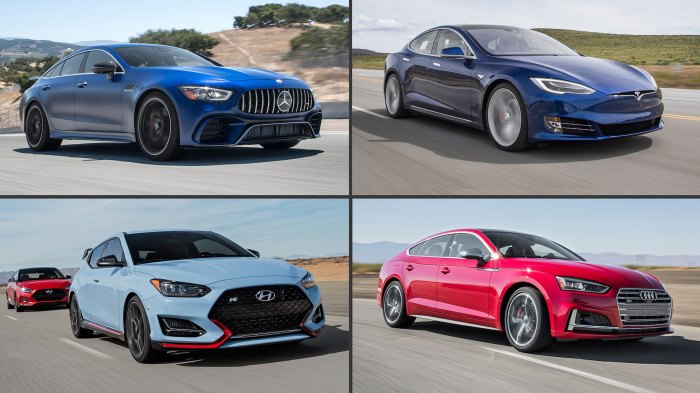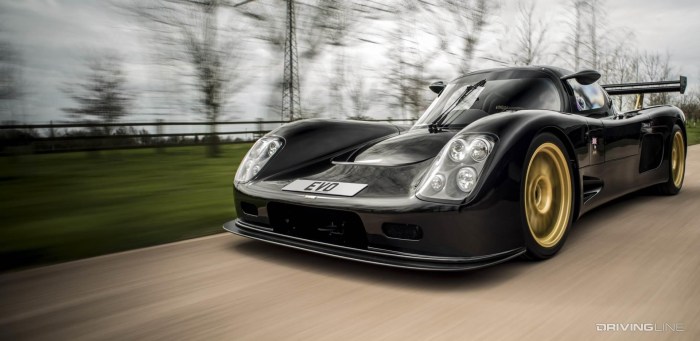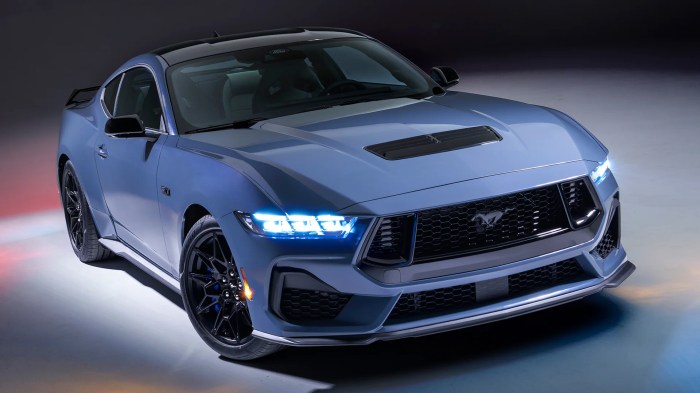Best cars for performance enthusiasts ignite the passion of driving, offering an unparalleled blend of speed, handling, and adrenaline. From roaring engines to sleek designs, these machines are engineered to deliver an exhilarating experience behind the wheel.
Delve into the world of performance cars, where every detail is meticulously crafted to enhance your driving pleasure. We’ll explore the key metrics that define performance, the intricacies of engines and drivetrains, and the importance of suspension and braking systems.
Performance Metrics: Best Cars For Performance Enthusiasts

Performance metrics are quantifiable measures used to assess a car’s capabilities. Enthusiasts often focus on acceleration, top speed, and handling when evaluating performance.
Acceleration measures how quickly a car can reach a certain speed, typically 0-60 mph or 0-100 km/h. Examples of cars with exceptional acceleration include the Tesla Model S Plaid and the Lamborghini Aventador.
Top Speed
Top speed refers to the maximum speed a car can attain. Cars with high top speeds include the Bugatti Chiron and the Koenigsegg Agera RS.
Handling
Handling encompasses a car’s ability to navigate corners and maintain stability at high speeds. Cars with excellent handling include the Porsche 911 and the Honda Civic Type R.
Engine and Drivetrain
The engine and drivetrain are the heart of any performance car. They determine how much power the car has, how quickly it can accelerate, and how well it handles. There are a variety of different engine and drivetrain configurations available, each with its own advantages and disadvantages.
The most common engine type for performance cars is the internal combustion engine (ICE). ICEs come in a variety of configurations, including inline-four, V6, V8, and V12. Inline-four engines are the most compact and lightweight, while V12 engines are the most powerful.
V6 and V8 engines offer a good balance of power and weight.
Another type of engine that is becoming increasingly popular for performance cars is the electric motor. Electric motors are more efficient than ICEs, and they produce instant torque. This makes them ideal for cars that need to accelerate quickly, such as drag racers and sports cars.
The drivetrain is the system that transfers power from the engine to the wheels. The most common type of drivetrain is the rear-wheel drive (RWD) drivetrain. RWD drivetrains are simple and lightweight, and they offer good handling characteristics. However, RWD drivetrains can be difficult to control in slippery conditions.
Another type of drivetrain is the front-wheel drive (FWD) drivetrain. FWD drivetrains are more efficient than RWD drivetrains, and they offer better traction in slippery conditions. However, FWD drivetrains can be less responsive than RWD drivetrains.
All-wheel drive (AWD) drivetrains combine the advantages of RWD and FWD drivetrains. AWD drivetrains offer good handling characteristics and traction in all conditions. However, AWD drivetrains are more complex and expensive than RWD and FWD drivetrains.
Engine Configurations
- Inline-four enginesare the most compact and lightweight engine type. They are often used in small cars and sports cars.
- V6 enginesoffer a good balance of power and weight. They are often used in mid-size cars and SUVs.
- V8 enginesare the most powerful engine type. They are often used in large cars and sports cars.
- V12 enginesare the most powerful and expensive engine type. They are often used in luxury cars and supercars.
Drivetrain Configurations
- Rear-wheel drive (RWD) drivetrainsare simple and lightweight. They offer good handling characteristics, but they can be difficult to control in slippery conditions.
- Front-wheel drive (FWD) drivetrainsare more efficient than RWD drivetrains. They offer better traction in slippery conditions, but they can be less responsive than RWD drivetrains.
- All-wheel drive (AWD) drivetrainscombine the advantages of RWD and FWD drivetrains. They offer good handling characteristics and traction in all conditions, but they are more complex and expensive than RWD and FWD drivetrains.
Suspension and Braking
When it comes to performance driving, suspension and braking systems play a crucial role in ensuring stability, handling, and stopping power. They work in tandem to keep the vehicle planted on the road and provide the driver with precise control, especially during aggressive maneuvers.
Suspension
The suspension system absorbs road imperfections and keeps the tires in contact with the road surface. It comprises various components, including springs, shock absorbers, and control arms, that work together to manage the vehicle’s weight and motion. A well-tuned suspension system enhances stability, handling, and ride quality, allowing the driver to push the car to its limits with confidence.
- Coil-over Suspensions:These offer a wide range of adjustability, allowing drivers to fine-tune the suspension settings for optimal performance on different road conditions.
- Air Suspensions:They provide adjustable ride height and damping, enhancing both performance and comfort. They can be found on cars like the Audi RS6 and the Mercedes-AMG S63.
Braking
The braking system is responsible for decelerating and stopping the vehicle. It consists of brake pads, rotors, calipers, and a master cylinder. Performance braking systems typically feature larger rotors, upgraded brake pads, and enhanced cooling systems to handle the increased heat generated during aggressive driving.
- Carbon-Ceramic Brakes:These offer exceptional stopping power, fade resistance, and durability. They are often found on high-performance cars like the Porsche 911 GT3 and the McLaren 720S.
- Brembo Brakes:Known for their reliability and high-performance capabilities, Brembo braking systems are commonly found on performance-oriented vehicles like the BMW M3 and the Ferrari 488 GTB.
Aerodynamics and Design
Aerodynamics and design play a crucial role in enhancing the performance of cars, especially for performance enthusiasts. Cars with sleek and aerodynamic designs can slice through the air with less resistance, resulting in improved speed, handling, and fuel efficiency.
Design
The shape of a car’s body significantly impacts its aerodynamic efficiency. Cars with sloping roofs, rounded edges, and flush-mounted components reduce drag and improve airflow. Some cars even incorporate active aerodynamic features such as spoilers that adjust their position based on speed to optimize airflow.
Aerodynamic Features, Best cars for performance enthusiasts
Spoilers and Wings
These devices create downforce, which increases traction and stability, especially at high speeds.
Diffusers
They accelerate air under the car, creating a low-pressure area that sucks the car down, improving grip.
Air Dams
These are placed at the front of the car to reduce air resistance and direct airflow more efficiently.
Hood Scoops and Vents
They allow air to flow through the engine bay, cooling components and reducing heat buildup.
Interior and Comfort
Interior design and comfort play a significant role in enhancing the driving experience for performance enthusiasts. A well-designed interior can provide a sense of connection between the driver and the car, while comfortable seats and a spacious cabin can reduce fatigue during spirited driving.Some cars that offer both performance and comfort include:
Sports Cars
Porsche 911
The 911 is known for its exhilarating performance and luxurious interior. It features supportive seats, a high-quality sound system, and a variety of convenience features.
BMW M3
The M3 combines blistering acceleration with a comfortable and well-equipped cabin. It offers adjustable seats, a large infotainment screen, and a spacious trunk.
Technology and Features

Modern performance cars are packed with advanced technology and features that enhance driving dynamics and elevate the enthusiast experience. These innovations range from sophisticated engine management systems to advanced driver assistance systems.
One notable example is the Porsche 911 Turbo S, which features a twin-turbocharged flat-six engine with variable valve timing and direct fuel injection. This combination delivers blistering performance, with 640 horsepower and 590 lb-ft of torque. The car also boasts an adaptive suspension system that adjusts damping rates in real-time to optimize handling and ride comfort.
Engine Management Systems
Advanced engine management systems play a crucial role in optimizing engine performance. These systems control various engine parameters, including fuel injection, ignition timing, and boost pressure. By precisely adjusting these parameters, engine management systems can maximize power output, improve fuel efficiency, and reduce emissions.
- Variable valve timing: Adjusts the timing of the intake and exhaust valves to optimize airflow and improve engine performance at different engine speeds.
- Direct fuel injection: Injects fuel directly into the combustion chamber, resulting in more efficient fuel combustion and improved power output.
- Turbocharging: Uses a turbocharger to increase engine power by compressing intake air, leading to increased air density and oxygen availability for combustion.
Driver Assistance Systems
Advanced driver assistance systems (ADAS) enhance safety and improve the driving experience. These systems can provide lane departure warnings, adaptive cruise control, and automatic emergency braking.
- Lane departure warning: Alerts the driver if the car is drifting out of its lane, helping to prevent accidents.
- Adaptive cruise control: Automatically adjusts the car’s speed to maintain a safe following distance from the vehicle ahead.
- Automatic emergency braking: Detects potential collisions and applies the brakes automatically to avoid or mitigate accidents.
Price and Value
Performance cars for enthusiasts come with a wide range of price tags, influenced by factors such as brand, performance capabilities, and exclusivity. Understanding the value proposition is crucial for making an informed decision.
The price of a performance car is often dictated by its engine power, handling capabilities, and overall performance. Cars with higher horsepower, advanced suspension systems, and sophisticated aerodynamics tend to command a premium price. Limited-edition models or cars with a strong racing heritage can also carry a significant price premium.
Factors Influencing Cost
- Brand Reputation:Established performance car brands like Ferrari, Lamborghini, and Porsche typically charge a premium for their vehicles due to their exclusivity and reputation.
- Performance Capabilities:Cars with impressive horsepower, acceleration, and handling capabilities usually come with a higher price tag.
- Rarity and Exclusivity:Limited-production models or cars with unique features can command a significant price premium due to their scarcity.
- Technology and Innovation:Cars equipped with advanced technologies, such as active suspension systems, carbon fiber components, and sophisticated infotainment systems, tend to be more expensive.
Determining Value for Money
When assessing the value of a performance car, consider the following factors:
- Performance-to-Price Ratio:Compare the car’s performance capabilities to its price to determine if it offers a good balance of power, handling, and value.
- Resale Value:Consider the potential resale value of the car, as it can impact the overall cost of ownership.
- Maintenance and Running Costs:Factor in the ongoing costs of maintaining and running the car, including fuel consumption, insurance premiums, and potential repairs.
- Emotional Appeal:While not directly related to value, the emotional appeal and desirability of a particular car can influence its perceived worth for enthusiasts.
Ultimately, the best value for money depends on individual preferences, budget, and the specific performance characteristics desired.
Comparison Table
To help you make an informed decision, we’ve compiled a table comparing the key features and specifications of some of the top performance cars for enthusiasts. This table includes metrics like acceleration, top speed, engine type, and price, providing a quick and easy way to compare these vehicles side-by-side.
Note that this table is not exhaustive and may not include all available models or configurations. Additionally, prices may vary depending on options and market conditions.
Key Features and Specifications
| Car | Acceleration (0-60 mph) | Top Speed | Engine Type | Price |
|---|---|---|---|---|
| Porsche 911 Carrera S | 3.5 seconds | 191 mph | 3.0L Twin-Turbocharged Flat-6 | $113,200 |
| Chevrolet Corvette Stingray | 2.9 seconds | 194 mph | 6.2L V8 | $60,995 |
| BMW M4 Competition | 3.8 seconds | 180 mph | 3.0L Twin-Turbocharged Inline-6 | $76,900 |
| Audi RS 5 | 3.9 seconds | 174 mph | 2.9L Twin-Turbocharged V6 | $74,200 |
| Mercedes-AMG C 63 S | 3.9 seconds | 174 mph | 4.0L Twin-Turbocharged V8 | $77,300 |
Buying Guide

For performance enthusiasts, selecting the ideal car is a thrilling endeavor. Here’s a comprehensive guide to help you navigate the process and find the perfect machine that aligns with your driving aspirations.
Factors to Consider
Begin by defining your needs and preferences. Consider the following factors:
Intended Use
Will the car primarily be used for track days, spirited driving on public roads, or a combination of both?
Performance Goals
Determine the desired levels of acceleration, handling, and braking capabilities.
Budget
Set a realistic price range that includes not only the purchase price but also ongoing maintenance and insurance costs.
Driving Experience
Assess your skill level and comfort with high-performance vehicles.
Practicality
Consider factors such as seating capacity, cargo space, and daily usability.
Final Review

Whether you’re a seasoned enthusiast or a newcomer to the world of performance driving, this guide will empower you to make an informed decision. Embrace the thrill of driving with the best cars for performance enthusiasts, where every journey becomes an unforgettable adventure.
Key Questions Answered
What are the key performance metrics for enthusiasts?
Acceleration, top speed, and handling are crucial metrics that measure the performance capabilities of a car.
What types of engines offer the best performance?
High-performance engines, such as V8s, V12s, and turbocharged engines, provide exceptional power and torque.
How important is suspension and braking in performance driving?
Suspension and braking systems are essential for maintaining control, stability, and stopping power, enhancing the overall driving experience.